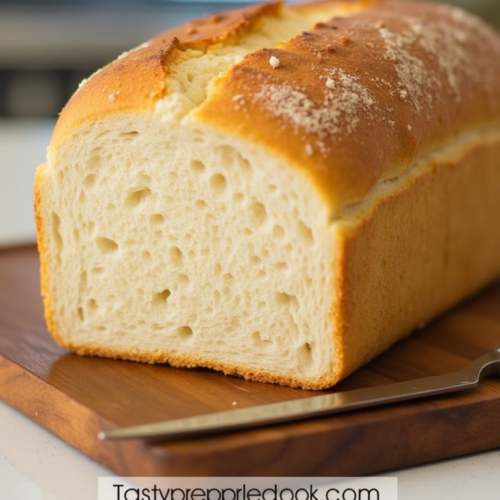
No-Knead Artisan Bread: Bakery-Style at Home
This no-knead artisan bread is simple to make and requires minimal effort. With just four basic ingredients, this crusty and flavorful bread is perfect for sandwiches, soups, or as a side with butter. The slow fermentation process enhances the flavor and texture, creating a bakery-style loaf at home.
Ingredients
- 3 ½ cups 440g all-purpose or bread flour
- 1 ½ teaspoons salt
- ¼ teaspoon instant yeast
- 1 ½ cups 360ml lukewarm water
- A Dutch oven or heavy-lidded pot
Instructions
- Mixing the Dough
- In a large mixing bowl, combine the flour, salt, and yeast. Stir in the lukewarm water until a shaggy dough forms. There’s no need to overwork it—just mix until everything is incorporated.
- The Long Rise
- Cover the bowl with plastic wrap or a clean kitchen towel and let it sit at room temperature for 12-18 hours. This slow fermentation allows the yeast to develop flavor and structure. The dough should be bubbly and doubled in size when ready.
- Shaping the Dough
- Lightly flour a clean surface and gently turn the dough out onto it. With floured hands, shape it into a rough ball by folding the edges toward the center. Be careful not to deflate the air bubbles that have formed.
- Second Rise
- Place the dough on a sheet of parchment paper and cover it with a towel. Let it rest for another 30-60 minutes while preheating your oven to 450°F (230°C). Place the Dutch oven inside as it heats to ensure it’s hot when the dough goes in.
- Baking the Bread
- Carefully transfer the dough (using the parchment paper) into the preheated Dutch oven. Cover with the lid and bake for 30 minutes. Then, remove the lid and bake for another 10-15 minutes to develop a deep golden crust.
- Cooling and Enjoying
- Remove the bread from the oven and let it cool on a wire rack for at least 30 minutes before slicing. This allows the interior to set properly, ensuring a perfect texture.
Notes
Use the Right Flour: Bread flour gives a chewier texture, while all-purpose flour results in a softer crumb.
Don’t Rush the Fermentation: A longer rise enhances flavor and structure.
Experiment with Add-ins: Try mixing in herbs, garlic, cheese, or dried fruit for unique variations.
Store Properly: Keep your bread in a paper bag or bread box to maintain its crusty texture.